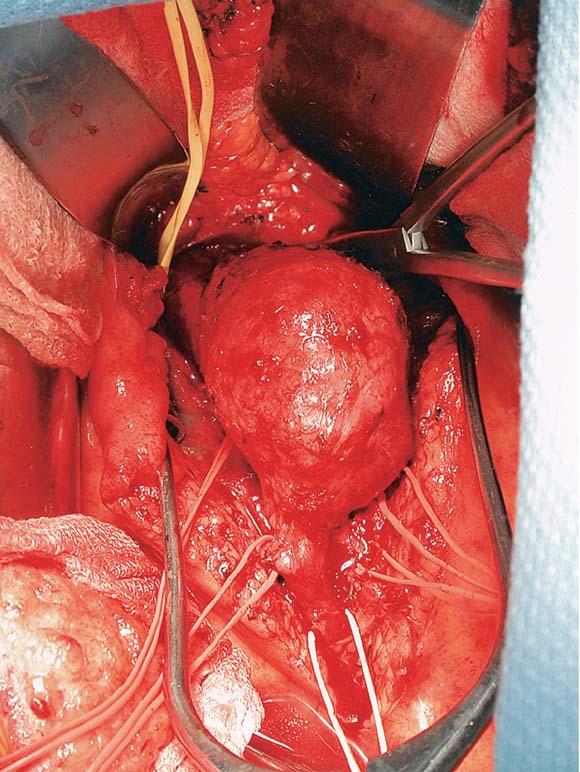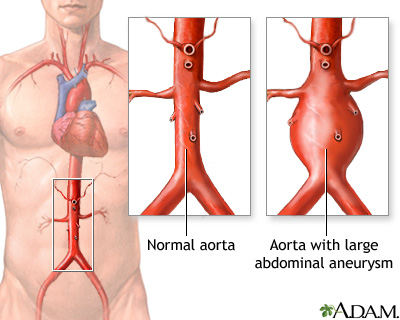
What is an aneurysm?
An aneurysm is an area of a localized widening (dilation) of a blood vessel. (The word "aneurysm" is borrowed from the Greek "aneurysma" meaning "a widening").
What is an aortic aneurysm?
An aortic aneurysm involves the aorta, one of the large arteries through which blood passes from the heart to the rest of the body. The aorta bulges at the site of the aneurysm like a weak spot on an old worn tire.
What are the thoracic and abdominal aorta?
The aorta is first called the thoracic aorta as it leaves the heart, ascends, arches, and descends through the chest until it reaches the diaphragm (the partition between the thorax and abdomen). The aorta is then called the abdominal aorta after it has passed the diaphragm and continues down the abdomen. The abdominal aorta ends where it splits to form the two iliac arteries that go to the legs.
Where do aortic aneurysms tend to develop?
Aortic aneurysms can develop anywhere along the length of the aorta. The majority, however, are located along the abdominal aorta. Most (about 90%) of abdominal aneurysms are located below the level of the renal arteries, the vessels that leave the aorta to go to the kidneys. About two-thirds of abdominal aneurysms are not limited to just the aorta but extend from the aorta into one or both of the iliac arteries.
What shape are most aortic aneurysms?
Most aortic aneurysms are fusiform. They are shaped like a spindle ("fusus" means spindle in Latin) with widening all around the circumference of the aorta. (Saccular aneurysms just involve a portion of the aortic wall with a localized out pocketing).
What's inside an aortic aneurysm?
Who is most likely to have an abdominal aortic aneurysm?
Aortic aneurysms are most common after 60 years of age. Males are five times more likely than females to be affected. Approximately 5% of men over age 60 develop an abdominal aortic aneurysm.
What are risk factors for aortic aneurysms?
Risk factors for aortic aneurysm include:
- Cigarette smoking: cigarette smoking not only increases the risk of developing an abdominal aortic aneurysm, the chance of aneurysm rupture (a life-threatening complication of abdominal aneurysm) is also more common among active smokers.
- High blood pressure
- High serum cholesterol
- Diabetes mellitus
What is the most common cause of aortic aneurysms?
The most common cause of aortic aneurysms is "hardening of the arteries" called arteriosclerosis. At least 80% of aortic aneurysms are from arteriosclerosis. The arteriosclerosis can weaken the aortic wall and the pressure of the blood being pumped through the aorta causes expansion at the site of weakness.
What are other causes of aortic aneurysms?
Other causes of aortic aneurysms include:
- Genetic/hereditary: There is a familial tendency to developing abdominal aortic aneurysms. Individuals with first-degree relatives having abdominal aortic aneurysms have a higher risk of developing abdominal aortic aneurysm than the general population. They also tend to develop the aneurysms at younger ages and have a higher tendency to suffer aneurysm rupture than individuals without family history.
- Genetic disease: There are also rare inheritable genetic diseases of connective tissue (tissue that make up the wall of the aorta) such as Ehlers-Danlos syndrome and Marfan's syndrome that can lead to the development of aortic aneurysms.
- Post-trauma: After physical trauma to the aorta.
- Arteritis: Inflammation of blood vessels as occurs in Takayasu disease, giant cell arteritis, and relapsing polychondritis.
- Mycotic (fungal) infection: A mycotic infection that may be associated with immunodeficiency, IV drug abuse, syphilis, and heart valve surgery.

The inside walls of aneurysms are often lined with a laminated blood clot that is layered like a piece of plywood.
Most abdominal aortic aneurysms produce no symptoms (they are asymptomatic). They are often incidentally discovered when abdominal ultrasounds and/or CT scan studies are ordered for other conditions. When they produce symptoms, the most common symptom is pain. The pain typically has a deep quality as if it is boring into the person. It is felt most prominently in the middle of the abdomen and can radiate to the back. The pain is usually steady but may be relieved by changing position. The person may also become aware of an abnormally prominent abdominal pulsation.
Abdominal aortic aneurysm can remain asymptomatic or produce mild to moderate symptoms for years. However, a rapidly expanding abdominal aneurysm can cause sudden onset of severe, steady, and worsening middle abdominal and back pain . A rapidly expanding aneurysm is also at imminent risk of rupture. Actual rupture of an abdominal aneurysm can cause sudden onset of back and abdominal pain, sometimes associated with abdominal distension, a pulsating abdominal mass, and even shock (severe low blood pressure due to massive blood loss).
How is an abdominal aortic aneurysm diagnosed clinically?
Careful palpation or feeling of the abdomen by a healthcare practitioner may reveal the abnormally wide pulsation of the abdominal aorta. This is characteristically felt on both sides of the aorta which is in the midline of the abdomen. Note that even large aneurysms can be very difficult to detect on physical examination in overweight people. Aneurysms on the verge of rupture and that are rapidly enlarging, are often tender. Listening with a stethoscope may also reveal a bruit or abnormal sound from turbulence of blood within the aneurysm.
What tests help in the diagnosis of an abdominal aortic aneurysm?
In about 90% of the cases, X-rays of the abdomen show calcium deposits in the aneurysm wall. But plain x-rays of the abdomen cannot determine the size and the extent of the aneurysm. Ultrasonography usually gives a clear picture of the size of an aneurysm. Ultrasound has about 98% accuracy in measuring the size of the aneurysm, and is safe and noninvasive. But ultrasound cannot accurately define the extent of the aneurysm and is inadequate for surgical repair planning.
Computerized tomography of the abdomen, is highly accurate in determining the size and extent of the aneurysm, and its relation to the renal arteries. However, computerized tomography uses high doses of radiation and for evaluation of blood vessels, requires intravenous dye. This carries some risk including allergic reaction to the dye and irritation of the kidneys. In patients with kidney diseases, the doctor may consider an MRA (magnetic resonance angiography), which is a study of the aorta and the other arteries using MRI scanning. Both computerized tomography and magnetic resonance imaging are effective for diagnosis. An aortogram, where dye is directly injected into the aorta to assess its anatomy, historically was the diagnostic test of choice. Presently, it's indications may be limited to use when surgery or stenting is considered (see below).
What is the natural history of abdominal aortic aneurysms?
The natural history of abdominal aortic aneurysms depends on their size and the speed of expansion. Rupture of aneurysms is uncommon when they are less than 5.5 cm wide and are expanding slowly. Rupture is far more common in aneurysms that are over 5.5 cm wide and are expanding rapidly (>0.5 cm/year). Surgical repair is therefore usually recommended for aneurysms over 5.5 cm wide.

What are the complications with an abdominal aortic aneurysm?
Rupture is a feared problem. Rupture of an abdominal aneurysm is a catastrophe. It is highly lethal and is usually preceded by excruciating pain in the lower abdomen and back, with tenderness of the aneurysm. Rupture of an abdominal aneurysm causes profuse bleeding and leads to shock. Death may rapidly follow. Half of all persons with untreated abdominal aortic aneurysms die of rupture within five years. Abdominal aortic aneurysms are the 13th leading cause of death in the U.S.
Peripheral embolization of clot within the aneurysm can occur when a piece of clot comes loose and travels further out in the arterial system. This clot fragment can lodge in a smaller artery and block the flow of blood. Infection of aneurysms can occur from turbulent blood flow from the rough inner surface of the affected aorta.
How are abdominal aortic aneurysms repaired?
The goal of surgical treatment of abdominal aortic aneurysm is to prevent aneurysm rupture. Traditionally, repair of aortic aneurysms has been surgical. The operation consists of opening the abdomen, finding the aorta and removing (excising) the aneurysm. A synthetic Dacron tube that replaces the removed piece of aorta is sewn into place.
A less invasive procedure for aortic aneurysm is endovascular surgery. This minimally invasive procedure that allows the grafts (stent) to be guided within the blood vessel itself to the site of the aneurysm without the need to cut open the abdomen. Not all aneurysms can be fixed in this manner and there may not be a long-term benefit to this type of surgery. Though the post-operative course is shorter, there is a need for closer follow-up and testing.

What is done if an abdominal aortic aneurysm threatens to rupture?
Threatened rupture of abdominal aneurysms is a surgical emergency. The operative risk for a ruptured aneurysm is about 50%. If kidney failure occurs after surgery, the prognosis (outlook) is particularly poor.
What is the medical management (non-surgical management) of abdominal aortic aneurysm?
For patients who are not surgical candidates (for example for patients with aneurysm smaller than 5 cm); medical treatment to prevent aneurysm expansion and rupture include:
- Stopping cigarette smoking
- Controlling high blood pressure
- Lowering high blood cholesterol
- Some doctors may consider medications called beta blockers, like propanolol (Inderal), atenolol (Tenormin), or metoprolol (Lopressor, Toprol XL), which block adrenaline receptors and lower pressure within the blood vessel.
- Close monitoring of the aneurysm size with ultrasound or CT scan every 6 to 12 months (sooner in high risk patients)
Abdominal Aortic Aneurysm At A Glance
- An aneurysm is an abnormal area of localized widening of a blood vessel.
- The aorta bulges at the site of an aneurysm like a weak spot on a worn tire.
- Aortic aneurysms are typically spindle-shaped and involve the aorta below the arteries to the kidneys.
- Five percent of men over 60 develop an abdominal aortic aneurysms.
- The most common cause of an aneurysm is arteriosclerosis.
- Abdominal aortic aneurysms often do not cause symptoms. If they do, they may cause deep boring pain in the lower back or abnormally prominent abdominal pulsation.
- X-rays of the abdomen and other radiologic tests can be used in diagnosing an aneurysm.
- Rupture of an aortic aneurysm is a catastrophe.
- Repair of the aneurysm can be done by surgery or endovascular stenting.
|
Bookmark this post:
|
|

1 Comment
Abdominal Aortic Aneurysm: Causes, Symptoms and Diagnosis
posted on: Sat, August 2010
posted by : norbert
An abdominal aortic aneurysm is said to have occurred, when the large blood vessel that carries blood away from the heart and supplies to the abdomen, pelvis and legs, dilates or bulges. This localised dilatation of the abdominal aorta exceeds the normal diameter by more than 50 percent. Aneurysms also occur in other areas of the aorta, but the abdomen is the most common site.
link:- http://www.heart-consult.com/articles/abdominal-aortic-aneurysm-causes-symptoms-and-diagnosis
Posted on October 29, 2010 at 10:23 PM
Post a Comment